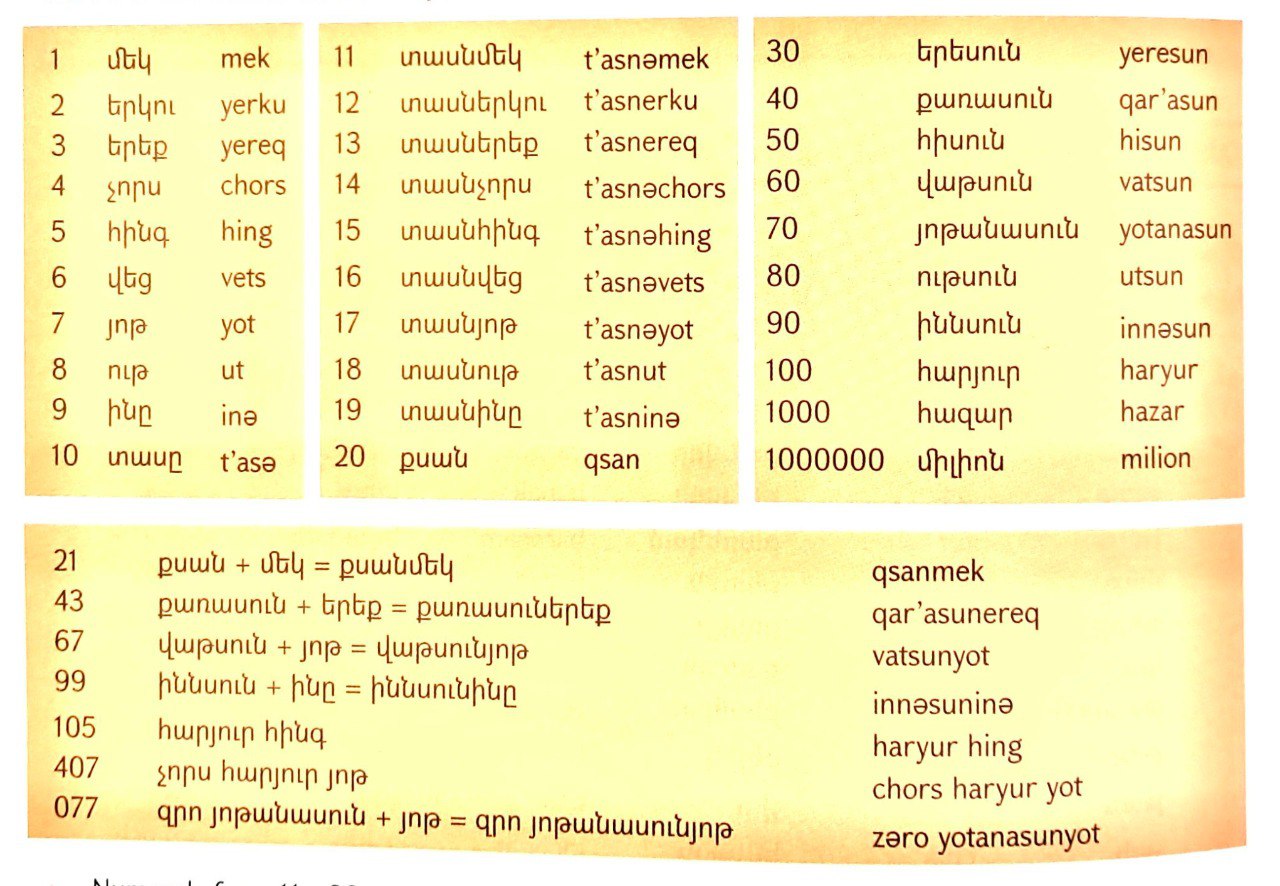Let's learn to count in Armenian, and at the same time find out how the Armenians wrote down numbers several centuries ago. Understanding the basics of the Armenian number system will help you expand your knowledge of the country's culture and traditions, as well as get a discount at the local vegetable market!
Contents
Basic numbers
Let's start with numbers from 1 to 10, as well as 100 and 1000. This will give you the opportunity to tell the store how many pita breads you want and determine the approximate amount in drams.
Numbers from zero to ten are concrete words.
0 – զրո [zro]
1 – մեկ [mek]
2 – երկու/ էրկու* [erku / erku*]
3 – երեք /իրեք* [erek/irek]
4 – չորս [chors]
5 – հինգ [hing]
6 – վեց [vets]
7 – յոթ [iot]
8 – ութ [ut]
9 – ինը [inə] (at the end – an unpronounceable vowel or close to a short “e”)
10 – տասը/տաս*[tasə/tas*]
The names of most tens are based on the roots of the numbers with the addition of the suffix -սուն [-sun]:
20 – քսան [ksan] (exception)
30 – երեսուն [eresun]
40 – քառասուն [karasun] (exception)
50 – հիսուն [hisun]
60 – վաթսուն [watsun]
70 – յոթանասուն/ յոթսուն* [yotanasun/ yotsun*]
80 – ութսուն [utsun]
90 – իննսուն [innsun]
Now to the heavy artillery:
100 – հարյուր [kharyur]
To say 200, 300 and so on, we add the quantity to one hundred, for example:
200 – երկու հարյուր (literally – 2 hundred)
300 – երեք հարյուր (literally – 3 hundred), etc.
1,000 – հազար [Khazar]
Colloquial pronunciations are marked under *.
The word “dram” is also useful in everyday life. In Armenian it looks like this: դրամ ֏ [dram]. And if you don’t hear the amount, don’t take out the largest bill from your wide trousers, but simply ask again: Ինչքա՞ն [inchkan] (How much?).
Composite numbers
Now let's move on to more complex combinations (not really). Composite numbers are constructed in the same way as is customary in the Russian language. So this shouldn't cause any particular difficulty.
First we write ten, and then put the required unit, separating them with a space. For example, 35 will be երեսուն հինգ [eresun hing], and 78 will be յոթանասուն ութ [yotanasun ut], leaving 99 for independent work.
Hundreds, thousands and their larger brethren follow the same logic. 1991 (year of independence of Armenia) is written as follows: 1000 – հազար [Khazar] 9 – ինը [inə] 100 – հարյուր [kharyur] 90 – իննսուն [innsun] 1 – մեկ [mek]. As a result, we get the required number - հազար ինը հարյուր իննսուն մեկ [Khazar inə kharyur innsun mek].

Photo: Արսեն Գոմցbedrom
From the history
To understand the basic principles of the Armenian number system, you should also know the history of its origin.
The creator of the Armenian number system is the linguist Mesrop Mashtots. He lived in the 4th–5th centuries. Coming up with 36 Armenian letters, the eminent linguist divided them into four rows: units, tens, hundreds and thousands. Thus, the letter “A” (Ա) was equal to 1, and the unvoiced “K” (Ք) was equal to 9000. If some rich nobleman needed a number greater than 9999, a dash above the letter came to the rescue. This instantly multiplied it by 10,000. In other words, from the combinations of Armenian letters one can count up to 99,999,999. And for a long time there was no need for more.

Image: Google.com
This unusual system was used in Armenia until the 17th century. Today it has been replaced by Arabic numerals. But where Roman numerals are usually found (for example, in the titles of book chapters), they are still written in Armenian.
The meanings of decades (numbers that are multiples of ten) in Armenian culture extend far beyond the purely mathematical. They symbolize energy, philosophy or even mood. Thus, the number 40 – “քառասուն” (karasun) personifies completeness or completeness.
Counting in Armenian is not only mathematics, but also a way to immerse yourself in the culture and history of Armenia. We hope that our article will help you master the Armenian counting system and open up an interesting cultural perspective.
If you are interested in Armenian, come to the free language express courses from Move2Armenia Culture. Announcements of new streams are published on the website.
















Add a comment